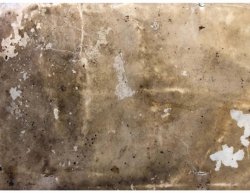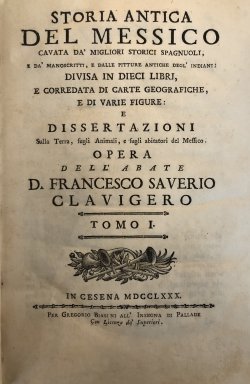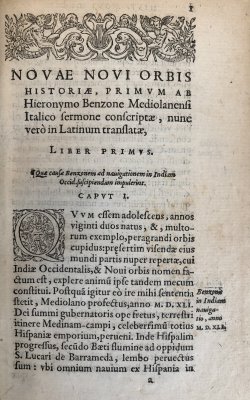The historical matrix of the project Memoria Presente: The Common Spanish Legacy in Italian and Latin American Cultures is linked to the exploration and conquest of the “nuovo mondo” (new world), to borrow from Amerigo Vespucci’s famous expression, on the part of the Spaniards with the participation of several Italian explorers (Italy at that time was a geographical expression, since before the 1861 unification it was a collage of smaller and larger states, kingdoms, duchies, republics, etc.: regional affiliations were thus very relevant to indicate provenance). Those sea voyages and related travels on previously unknown lands produced a vast body of literature that, starting in the first half of the 1500s, involved Italians as writers, compilers, transcribers, translators and printers. Interestingly, foreign explorers, conquerors, and chroniclers (Spaniards for the most part) also wrote in Italian and in some cases while living in Italy, mostly in exile. At that time, Italy was a vital printing center and the highly cultured “Italian” spoken and written was one of the most used in Europe, and changed depending on the location (Venetian, Florentine, etc.).
This section of the Memoria Presente project includes excerpts from select rare books belonging to the Wilson Library’s Special Collections at the University of North Carolina, Chapel Hill, and in particular the Bernard J. Flatow Collection of Latin American Cronistas. See annotated bibliography of the collection items.
- Lettere scritte al signor Pietro Aretino da molti signori, communità, donne di ualore, poeti, & altri eccellentissimi spiriti compiled by Francesco Marcolini da Fortì(Venetia, 1552). For a description, see item 47. p. 155 of the Flatow Collection’s annotated bibliography.
The book is a collection of letters purportedly written to Pietro Aretino by his admirers: the language of praise in them is so excessive that the letters are more of an indication of his narcissism than a reflection of actual relationships in the Venice society he was active in. Born in Arezzo in 1492, Aretino was an accomplished man of letters whose questionable ethics (blackmailing, dissolute life) were as famous as his contributions to poetry, drama and satire.
One letter in particular is of relevance for the Memoria Presente project: it was written by Gianambrogio degli Eusebii, also known as Ambrogio Eusebi, Aretino’s servant/secretary. Ambrogio Eusebio traveled throughout Europe and South America to retrieve his master’s funds but actually squandered it in gambling. This letter is of great importance for its description of one of Eusebio’s travels, the one in the Riverplate region, comprising parts of today’s Argentina, Brazil, Uruguay and Paraguay. Most likely written between the late 1530s and the early 1540s in Asunciòn, the text is of relevance for its early description of the area, as well as for its mention of the imprisonment of Cabeza de Vaca. The letter contains: 1. An awe-filled description of the Paranà River which Eusebio refers to as “grandissimo mare” (p. 30) and a general illustration of the area as “terra miserabile,” for the visitors due to its harsh terrain and heavy rains; an incisive comment about the season inversion (“In June there is the most intense cold here and at Christmas time the more intense heat” – p. 31); the presence of indigenous people (including the extremely independent Amazons); and, of particular importance to the Memoria Presente project, a reference to the circulation of Venetian beads brought by Genoese businessmen, evidence of the early Italian presence in the “new world” in terms of commercial activities. See: Digitized copy of the letter.ACTIVITIES
Students at the advanced level can be introduced to this old text from a purely formal and aesthetic perspective first, focusing on the typography in order to identify the specific shape of letters (the “s” looks like an “f,” for instance), as well as on the syntax (the first page is only one long sentence, made up of numerous clauses separated by semicolons). The latter shows students how long sentences in Italian are the legacy of this older models, and despite the historical adjustments, there is still a tendency in written Italian to use long sentences. The condensed expressions required by social media, txt-based communication, and the influence of English have certainly changed the ways in which Italians write today, but formal documents (legal one, mainly) retain this quality to a degree. Interestingly, this is also a characteristic of written Spanish. Students may be asked to “translate” the text into contemporary Italian in terms of vocabulary and syntax.Students may also analyze the beginning of the text as a magisterial example of the art of ingratiating. The writer is both justifying himself to regain the trust of his master after his questionable actions, and celebrating the glory and aura of his master to continue representing his interests abroad. Students may be invited to write a letter to a famous personality in Italy (politician, actor, singer, the Pope, influencer) using a similar (yet properly calibrated) introduction where the addressee’s quality are highlighted as a way to set up a targeted communication (the students will decide the purposed of the letter).
Finally students may want to look at the text in comparison to Edmondo De Amicis’ novella “From the Apennines to the Andes:” they both present an Italian character traveling in the Riverplate area, albeit for different reasons (commercial in the former text and personal in the latter), and his reaction to the unique nature of the region. See Literature and Film section of Memoria presente. The activity can include a piece of adventurous travel writing based on the students’ actual or imagined journeys.
- Storia antica del Messico: cavata da’ migliori storici spagnuoli, e da’ manoscritti, e dalle pitture antiche degl’ Indiani…e dissertazioni sulla terra, sugli animali, e sugli abitatori del Messico written by D. Francesco Saverio Clavigero (Cesena, 1780-1781). For a description, see item17 p. 90 of the Flatow Collection’s annotated bibliography.
This book in four volumes contains section devoted to cocoa and chocolate in Mexico: the description of the cocoa plant, information about production quantities, references to its use (as currency and drink), details about consumption (hot drink with added flavors) and preparation with tools (metate). See also the section Food, Cuisine and Gastronomy of the Memoria Presente project.In the same vein of Las Casas’ reports, Mexican Jesuit Francisco Javier Clavijero wrote this book to challenge the popular chronicles of the Americas that represented indigenous people as inferior to the European conquerors. Clavijero offers an encyclopedic view of Mexico embracing botany, anthropology, and history, to name a few fields, with a plethora of details and a substantial amount of respect for the local culture, which he analyzed in person, through direct contact with people and pre-existing texts (he knew local languages), and in dialogue with contemporary historians. He wrote his chronicle, enriched by maps, illustrations, and an astonishingly precise index, during his exile Italy, when Jesuits were expelled from Spain.
ACTIVITIES
Students are invited to read these excerpts and compare them to more contemporary accounts of the preparation of Aztec chocolate, paying particular attention to instruments and ingredients used back then and today. A final project can include the actual preparation of hot chocolate or chocolate bars as illustrated in the COIL project under Food, Cuisine and Gastronomy of the Memoria Presente project. - Paesi nouamente retrouati et nouo mondo da Alberico Vesputio Florentino intitulato compiled by Fracanzano da Montalboddo (Vicentia, 1507). For a description, see item 31 p. 125 of the Flatow Collection’s annotated bibliography.
- La historia del Mondo Nvovo: la qval tratta delle isole, & mari nuouamente ritrouati, et delle nuoue città da lui proprio vedute, per acqua, & per terra in quattordeci anni by M. Girolamo Benzoni Milanese (1565). For a description, see item 9 p. 71 of the Flatow Collection’s annotated bibliography. See digitized manuscript.
Penned by Girolamo Benzoni (b. 1519), this journalistic account is a highly critical account of events in the Indies derived from the author’s own travels throughout the Caribbean and in the present-day territories of Venezuela, Colombia, Panama, Costa Rica, Nicaragua, Guatemala, and ultimately Ecuador, in the search fo riches that never really materialized. This history was immensely popular when it first appeared in Italy (chronicles found avid readers in Italy), and it was often translated and used as propaganda against the Spaniards.




